Displaying items by tag: Jade O'Connor
#Kitesurfing - It's Battle for the Bay time on Dollymount Strand this weekend (23-24 May), and The 42 brings us a preview of the kitesurfing action you can expect on Bull Island today and tomorrow.
Cheering on the competitors from the beach will be Irish medal winner Jade O'Connor, who's currently campaigning for a spot at a future Olympics when the sport makes its debut (potentially at Tokyo 2020).
And in her role as ambassador, O'Connor also has high praise some of the other action in Dublin Bay's waters, via the related discipline of boardercross – essentially kitesurfing on an obstacle course – and the crowd-pleasing freestylers.
“It’s really visual and it’s about jumping really high, like up to 20 metres in the air and doing tricks,” says the current British Ladies Champion.
The 42 has more on the story HERE.
Medal Winning Kitesurfer Jade O'Connor Launches Campaign Video
#kitesurf – Medal winning Irish kitesurfer Jade O'Connor, who finished third overall in the Formula Kiteboarding Class in the important Palma Eurosaf regatta a month ago, launched a new campaign video in Clontarf last night.
O'Connor, who was named 'Woman Of The Year 2014' at Outsider Magazine's Awards, had an outstanding 2014 which saw her achieve eighth overall at the Worlds, fourth at the Europeans, and is the current British Ladies Champion. Jade competes in ISAF's Formula Kiteboarding Class which was showcased at ISAF Abu Dhabi Grand Finale last November.
The short film 12 minute film about O'Connor, who is Ireland's only representative at international level at the sport of Kite Racing covers her progress as the 2015 racing season kicks off and looks at some of O'Connor's winter training.
The kites made their first appearance in Palma this year for the Trofeo Sofia event. Ten challenging races were sailed by a mixed teams of male and female riders coming from all over the world to mark history witht the debut of kite racing alongside the usual ten Olympic classes.
Dublin Kitesurfer Medals at Spanish Olympic Sailing Event
#jadeoconnor – An Irish kitesurfer has taken Ireland's first podium finish of the 46th Trofeo Princesa Sofía 'Palma Olympic Class Event in Palma this evening. Dubliner Jade O'Connor finished third overall in the Formula Kiteboarding Class, six points behind Russian Anastasia Akopova on 23 points. Felllow Russian Elena Kalinna was a clear winner of the Spanish series on nine points in the five–strong fleet after three medal races sailed this afternoon.
O'Connor was named 'Woman Of The Year 2014' at Outsider Magazine's Awards. She had an outstanding year which saw her achieve eighth overall at the Worlds, fourth at the Europeans, and is the current British Ladies Champion. Jade competes in ISAF's Formula Kiteboarding Class which was showcased at ISAF Abu Dhabi Grand Finale last November, and is now included along side the 10 Olympic Classes at future ISAF World Cup events, including Palma.
The kites made their first appearance in Palma this year for the Trofeo Sofia event. Ten challenging races were sailed by a mixed teams of male and female riders coming from all over the world to mark history witht the debut of kite racing alongside the usual ten Olympic classes and the 2.4 pralympic event.
Elena Kalinina from Russia won all the races in the women division: "I am so excietd with my results here. I really didn't expect to win all the races. The racing conditions were not easy but in the end we did 10 races. The venue today in Can Pastilla was much better for launching and for racing. I hope we will be there next year. It was great to be part of the Trofeo Sofia IBEROSTAR with all the other Olympic classes, it is a great start for our future and hope we will be included again in more regattas with the Olympic classes." About her goals for the rest of the year the 18 years old Russian rider adds: "This win is giving me confidence to go and compete in the year main regattas: the European and world championship. Then I hope to be selected for the Sailing World Cup final in Abu Dhabi." Same reaction from Florian Trittel who took nine races out of ten. "I am very proud to win this event in Palma. I hope we will return next year with more riders. This is a good step towards the inclusion of kite in the Olympic Games!"
#kitesurf – Dublin based Kiteboarder Jade O'Connor was named 'Woman Of The Year 2014' at Outsider Magazines Awards last night. She had an outstanding year which saw her achieve eighth overall at the Worlds, fourth at the Europeans, and is the current British Ladies Champion. Jade competes in ISAF's Formula Kiteboarding Class which was showcased at ISAF Abu Dhabi Grand Finale last November, and is now included along side the 10 Olympic Classes at future ISAF World Cup events.
Jade said "I'm over the moon' to collect the award. It's a huge honour in light of the amazing achievements of the other athletes and adventurers nominated. This kicks my 2015 race season off with a bang of good energy". Having recently added goldenpages.ie as sponsors along side PureMagic she is excited to mount a full campaign representing Ireland at ISAF and Championship events this year. Her first event is Palma's SAR Princesa Sofia Regatta in March, which is a pre-qualifier for Sailing World Cup Hyeres the following Month.
The Outsider Magazine Awards showcases Athletes, Adventurers, Photographers, Videographers, Event Organisers and Adventure Companies who complete incredible feats or contribute to outdoor life on home soil or abroad. It's a celebration of the diversity and outdoor achievement, binding many individuals under a common banner of striving to do great things in their chosen field.
Some of the people honoured this year include -
Person of the Year 2014 - Tony Mangan, ultra runner
He ran the whole way around the world and longer than anyone else has ever run. His feat is the equivalent of 1,200 marathons.
Lifetime Achievement Award - Maurice Mullins
Pioneer, forward thinker, influencer, legend; all words used to describe Maurice Mullins, the man who introduced triathlon events to Ireland.
Kitesurfer Jade Scores Personal Best at Chinese World Championships
#kitesurf – After 61 races over 5 days, with 150 sailors from 45 countries the IKA Kiteboard Racing World Championship drew to a close yesterday.
Florian Gruber from Germany took the crown from ISAF Sailor of the year nominee Johnny Heineken in convincing style as lightwinds dominated the final two days of the event. Erika Heineken continues to reign as the Ladies World Championship, with a near flawless set of bullets.
Irish Rider Jade O'Connor. Finished in 12th position overall in the ladies fleet. Up 15 places from 27th in last years World Championships in Sardinia.
"Its been an amazing year for me, I started my season in Egypt at the African Championships in March and have improved every event since.
My goal for this year was top 20 and I've blown that out of the water. I'm amp'd for the new season to start and know exactly what I have to do to improve. Special thanks to my friends, family and sponsors for all the support" she said earlier.
Jade O'Connor Moves Up Kiteboard World Rankings in China
#kitesurfing – The skies of Bo'ao, Hainan, China have never looked so busy after two days of solid racing as 140 plus sailors from 45 countries compete at the Kiteboard Racing World Championships.Irish Sailor Jade O'Connor moved up the rankings of the ladies fleet today. She's currently positioned 12th overall with an improving scoreline, posting a 10th and 7th in race 5 & 6 respectively.
ISAF Sailors Of The Year nominees Erica & Johnny Heineken stamp their authority with an obvious speed and angle advantage. The remaining places are hard fought amongst the worlds best kite racers in testing conditions with solid winds over 20 knots for the last two days and set to continue for the remainder of the event.
O'connor declared after racing today – 'Super happy!!! I'm riding like i'm on fire, a couple of shockers when I get taken out on the start by other sailors or trash in the water catching my fins but that's racing, and the same for everyone else. After 2 days I'm 12th overall at the World Championships with a scoreline of 15, 26, 16, 14, 10, 7, 14'.



































































